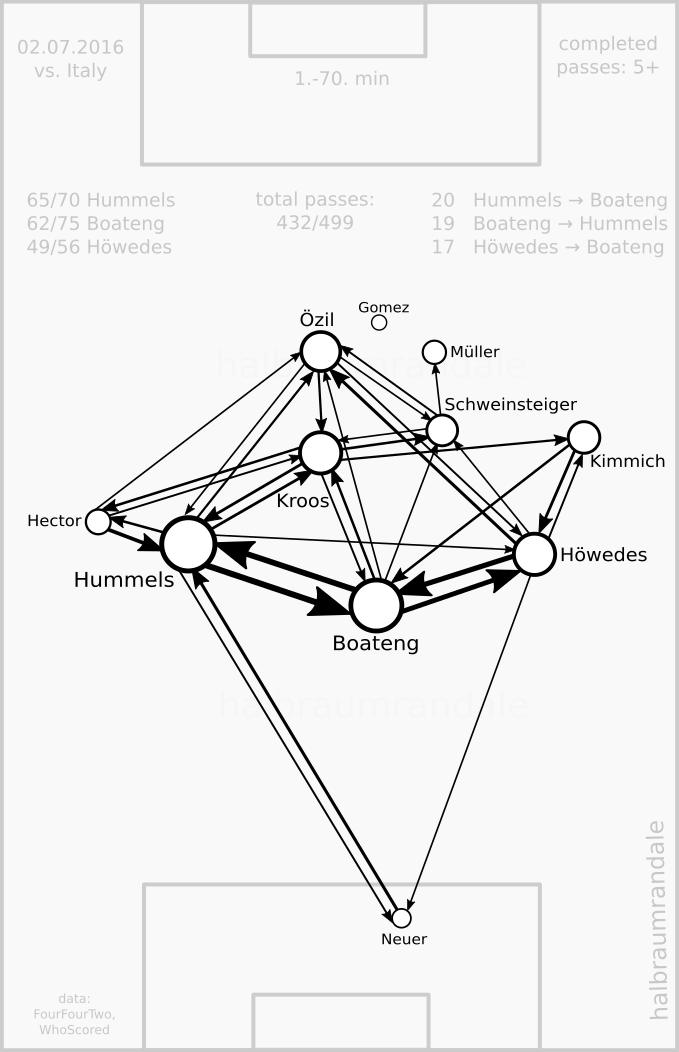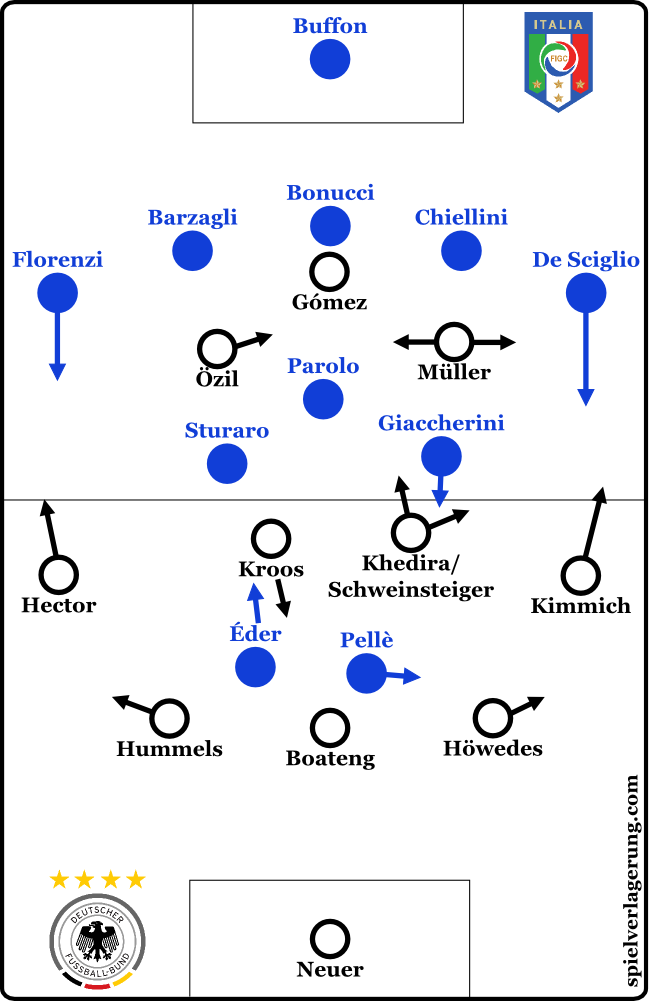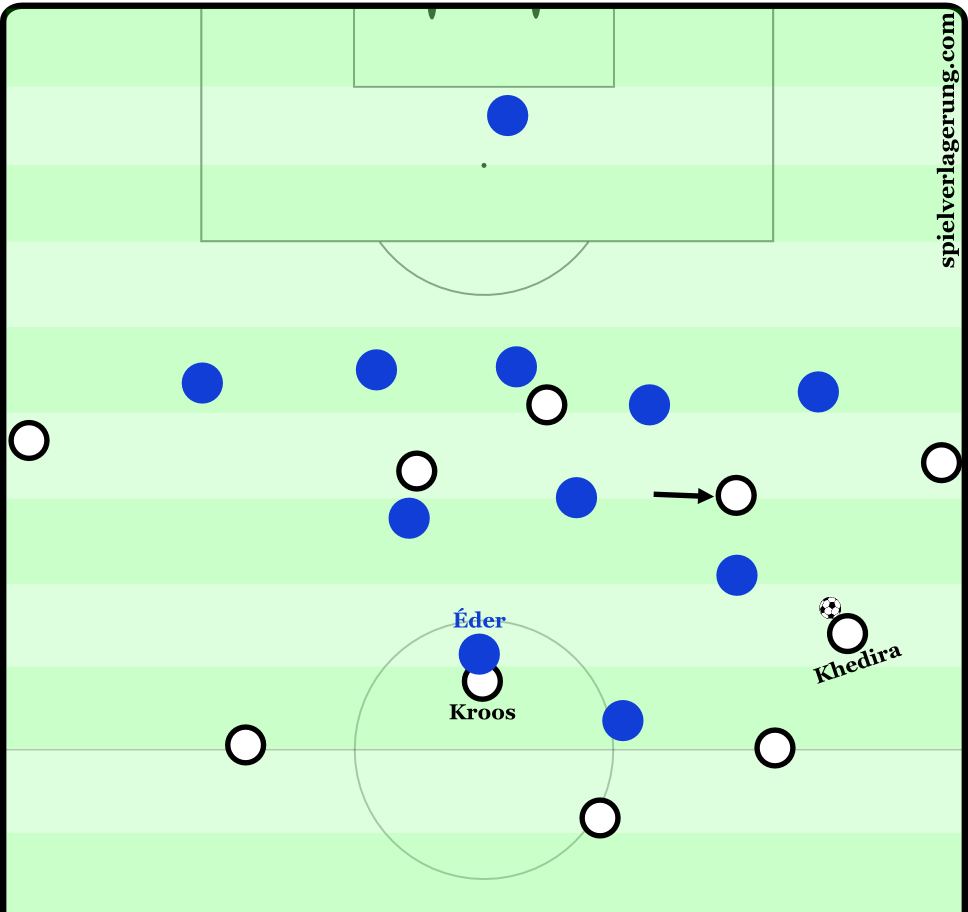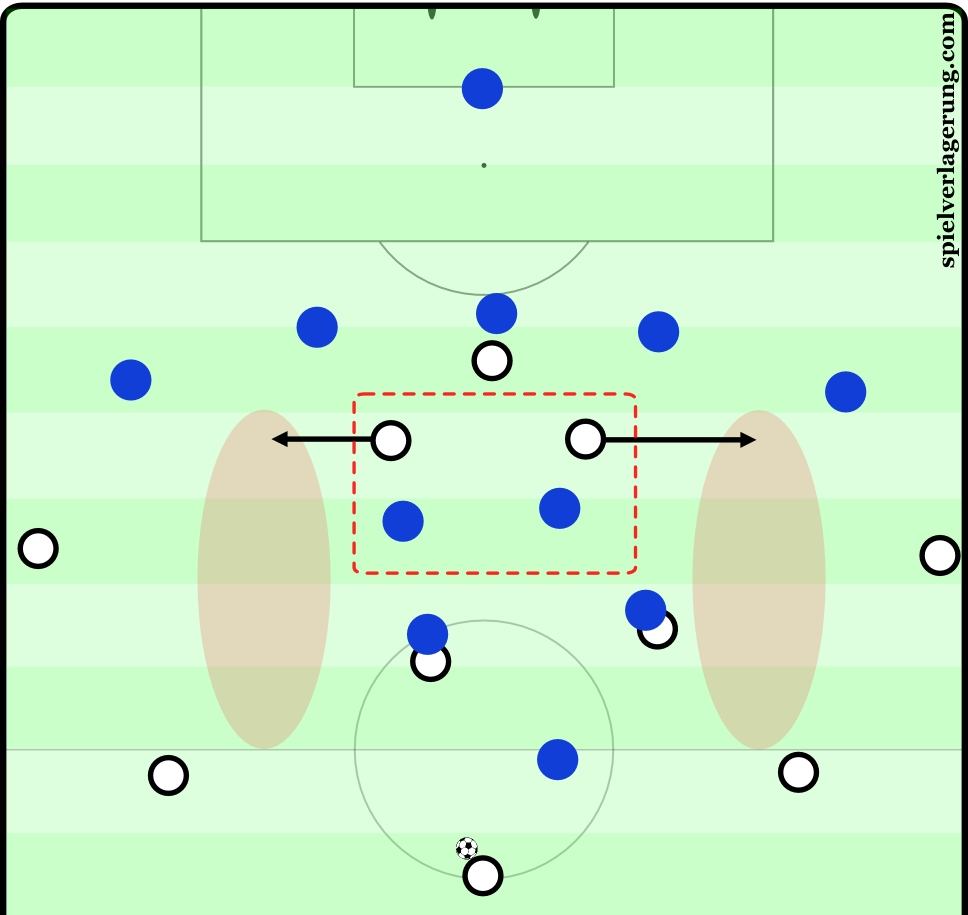The thriller in Bordeaux
Accipicchia! Meine Güte! Probably the two best teams of the Euro tournament had to battle each other in the quarterfinal. After 120 minutes full of tactical brilliance, passion and drama, Germany won the penalty shootout and sent Italy home.
Line-ups
Expectedly, Joachim Löw changed his system for the first time in the tournament, as he switched to a back three. Therefore, the German coach dropped Julian Draxler and brought in Benedikt Höwedes as an additional centre-back alongside Mats Hummels and Jérôme Boateng. Toni Kroos and Sami Khedira acted as centre-midfielders in what was a 3-4-2-1.
Antonio Conte, meanwhile, had to deal with a lack of available holding midfielders, because Daniele De Rossi injured his rip in the previous match, while Thiago Motta got his second booking and was therefore suspended. Conte, who hadn’t selected Napoli’s Jorginho to the roster, moved Marco Parolo to the holding role and fielded Stefano Sturaro as a number eight.
Löw’s smart moves
With three defenders that used the width of the pitch, Germany were able to play around Italy’s first block without getting enmeshed in too many one-on-ones in the own half. Toni Kroos was often the dead man early on, as Éder marked him closely. But that also meant that Éder couldn’t pressure Boateng or the other two centre-backs.
Sami Khedira immediately charged forward in the first phase of Germany’s build-up play, so his marker, Emanuele Giaccherini, followed him and couldn’t pressure the opposing defenders, either. Unfortunately for Khedira, he picked up an injury (adductor tear) early on which led to his substitution. Bastian Schweinsteiger replaced Khedira and played a similar role in the first half, although the Manchester United star drifted towards the right side more often. However, these runs didn’t really help, because both Höwedes and Joshua Kimmich were still wide and the half-space wasn’t utilised.
That said, Germany were normally effective when they played a diagonal ball towards Italy’s middle block and then moved the ball behind the line quickly afterwards. In those situations, both Mesut Özil and Thomas Müller were really helpful. They acted as inside forwards who usually started in narrow positions, but then drifted towards the wing when the ball was on their respective side. Thus they were able to receive through balls diagonally behind Parolo and Sturaro.
Italy’s defensive approach
Italy tried to react to Germany’s possession structure. In a somewhat second phase of pressing, both wing-backs frequently pushed forward to situationally pressure the wider centre-backs, but due to the fact that Germany’s wing-backs were positioned high up the pitch they couldn’t do it without taking the risk of being outplayed and exposing the wing zones. Therefore, the Italian wing-backs were more hesitant than in their previous match against Spain, when Mattia De Sciglio and Alessandro Florenzi bombed up and down the flank ceaselessly. Against Germany, they had to keep the back line compact, not allowing any runs behind the defence.
Nevertheless, Italy’s pressing wasn’t ineffective at all. Despite being clearly outnumbered up front, Graziano Pellè and his team-mates were brilliant in deploying angular movement to make use of cover shadows. Speaking of angles, Boateng seemed to feel uncomfortable with his position in the middle of the defence. The 27-year-old usually didn’t have the right angles to play his famous long balls across the field.
In contrary, Hummels had the freedom to dribble a few yards forward or play short and long passes on the left side. Plus, Germany made use of their goalkeeper in a far better way than Spain. They were mostly able pass the ball backwards to re-start the attacking play. Manuel Neuer helped the German defenders, when Italy pushed forward and pressured them in a man-orientated manner. Then they could turn around and involve the free man.

Passing map courtesy of @halbraumrandale
While that worked out quite well for Germany, the effectiveness of their wing-backs was rather bad. Jonas Hector and Joshua Kimmich moved high up the pitch early in the build-up play. After receiving the ball, they were too close to the opposing wing-backs to get the ball in between the lines most of the time.
So they were forced to play the ball back into the central midfield or to one of the defenders. That became a theme throughout the match. Germany normally passed the first block quite easily, but then didn’t go on to penetrate the opponents’ box as fast as possible. Quite the contrary, Löw’s players moved the ball backwards and re-collected before attempting to make the next step – namely including Mario Gómez and the other players up front in the process.
Pressing by the book
Prior to that match, Germany struggled to employ an intense pressing and counter-pressing scheme. Against the likes of Slovakia or Northern Ireland, that weakness didn’t cause much damage. Yet, it was clear that in an encounter with Italy the Germans should show improvements. And they did to some extent.
Particularly in counter-pressing, Khedira’s runs in build-up helped to create pressure in small areas in the middle. Later, Schweinsteiger’s tendency of drifting towards the right side diminished that factor, though. When Italy were building up, the right-sided centre-midfielder often pushed forward to watch the space between Giorgio Chiellini and De Sciglio and prevent passes.
After the half-hour mark, it became apparent that, even though Germany showed a good positional game, their pressing wasn’t nearly as surprising as it should have been in order to come in superior numbers in certain zones. The players up front made proper runs towards the three defenders and Parolo, while both centre-midfielders marked the opponents in their respective zones, but nothing special happened that could have caught Italy on the wrong foot. The Squadra Azzurra became increasingly calm when building up, so they could figure out how to move the ball down the middle, as Germany didn’t apply enough pressure.
Moreover, Germany struggled to get back into their pressing formation quickly enough after defending deep in their half and clearing the ball. Italy’s chance in the 43rd minute highlighted this kind of problem, as Leonardo Bonucci received the ball at the half-way line while Germany were still in or near their penalty box. Bonucci felt no pressure whatsoever and had enough time to screen the pitch and spot Giaccherini making a run behind Germany’s back line. Giaccherini stayed onside to receive the pass, then cut back a pass from the by-line. It skipped right past Florenzi, who was waiting to tap in. Sturaro lashed a shot that fell wide of the far post after a touch from Boateng.
Second half
Löw made a few adjustments during the interval. Schweinsteiger gave up his wider role and was now more present in the middle, which helped Germany to press in packs after turning the ball over. Germany’s back line was rather asymmetrical with Höwedes acting like a full-back and being positioned as high as Hector on the left side. Meanwhile, Hummels remained deep and offered a short passing option to Boateng.
Speaking of Germany’s left side, Hector seemed to be out there on his own. After the half-time break, Özil often roamed through the right half-space, while Schweinsteiger was now a left-sided midfielder, although this set-up changed frequently. But, in fact, neither Schweinsteiger nor Müller supported Hector to any noteworthy degree.
20 minutes into the second half and after a quite uneventful phase, Germany took the lead thanks to Gómez’ flash of genius. Moments before, Neuer was forced to knock the ball down the left where Müller pass the ball on to Gómez, who moved towards the corner flag while protecting the ball against two opponents. In the meantime, Hector decided to charge through the half-space which Gómez observed from the corner of his eye. The centre-forward fooled the defenders as he looked backwards, but clearly waited for the right moment to play the ball laterally, finding Hector on an overlapping run. The left-back’s pass to the centre of the penalty took a deflection off of Bonucci and fell directly into Özil’s path to score.
Minutes later, Gianluigi Buffon prevented Germany from doubling their advantage as Hummels played in Gómez, but the goalkeeper was there to tip over the forward’s brilliant attempt with his back to goal.
Germany’s adjustments paid off, as their formation in midfield allowed them to react to Italy’s man-marking scheme more flexibly. Even after scoring the go-ahead goal, Löw’s team didn’t lose their focus or give up their strategic direction. That said, after an injured Gómez had to leave the pitch and was replaced by Draxler, Italy enjoyed their first longer spell of possession after the break.
Conte changed his system into a clear-cut 3-4-3 that generated more pressure up front, kept Germany in their third for a few moments and allowed Italy to play some crosses and get a few set-pieces. On 78 minutes, Boateng was then caught with both arms above his head as he tried to get in front of Chiellini to clear a cross-pass. Bonucci made no mistake with a well-taken penalty to level the score.
Afterwards, two things happened in regards to Germany’s attacking game. First, Schweinsteiger was virtually everywhere. The skipper tried to provoke mistakes by running into the danger zone, but also helped his team-mates deep in the German territory to start plays. Second, Löw’s team were too static in the final phase of the match. Three or more players were waiting up front, while there was little to no interaction between the different parts of the formation. That led to a bad attacking rhythm and worrying degree of instability.
Meanwhile, Conte brought in Matteo Darmian who replaced Florenzi on the right side. Not only was Florenzi exhausted, but the Italian coach wanted fresh legs against Hector who didn’t seem to be too comfortable in defence.
Extra time
The game headed to extra time, where Germany continued to play in a 3-5-2 with Özil and Schweinsteiger as number eight players. Both teams looked rather hesitant, as nobody on the pitch wanted to commit the deciding mistake. In the case of Germany, that meant that there were less advancing runs and more long-distance passes towards the offside-line. Löw’s side had the chance to take back the lead when they pushed forward on a counter-attack, but Draxler’s through ball into the box was out of Muller’s reach.
Italy’s lone chance of extra time was Lorenzo Insigne’s angled shot in the 113th minute. Other than that, the Squadra Azzurra were innocent, and the frequent arguments between Giaccherini and Pellè were more entertaining than Italy’s entire attacking game.
The penalty shootout delivered some entertaining moments as well. For instance, Simone Zaza, who came on moments before the shootout, made probably one-hundred mincing steps just to sail his attempt over the bar. Bonucci, Pellè, Özil, Müller and Schweinsteiger missed, too. After eight rounds and 5-5 on the scoreboard, Neuer saved Darmian’s low shot, and Hector got his effort under Buffon to end it.
Conclusion
Following the match, a debate about the necessity of Löw’s pre-match changes arose among German pundits and fans. To put it short, a system including a back three was without any alternative. Italy’s win over Spain illustrated how well the Squadra Azzurra can close down a conventional back four when the opponents try to build up. With an additional centre-back and a right-sided midfielder who kept Giaccherini busy, the Germans more or less neutralised the threat of Italy’s pressing.
Conte and his players don’t have to be ashamed, though. Lacking the creativity of Claudio Marchisio and Marco Verratti, they performed very well throughout the tournament and even fought with the best team in the world to a draw. Once again in an international tournament, Italy impressed with a workmen-like approach – but also showed glimpses of brilliance in ball possession.






6 Kommentare Alle anzeigen
Achter July 4, 2016 um 8:48 pm
Does anyone know Zaza’s penalty record? I only see people making fun of him but maybe had a 100% conversion rate before… I mean he said he always takes them like that so it’s not something he’s done for the first time but rather something he seems to think about…
Like Müller saying he will practise his penalties before he starts taking them again
CE July 5, 2016 um 9:42 am
In the last five seasons, he had three penalties – all for Sassuolo – and scored twice. I even told my colleagues, when Zaza came one, that he is a decent penalty taker. That said, it still looked awkward.
Achter July 5, 2016 um 8:42 pm
Haha ok. I tried googling that info but there was no chance that could have been successful 😛
Danny July 4, 2016 um 3:17 pm
How much will Germany miss Hummels? I suspect we’ll see Gotze reintroduced for Gomez as well….. Los Gehts Die Mannschaft!
CE July 5, 2016 um 9:44 am
They will certainly miss him, but Löw has decent alternatives in Mustafi and Höwedes. Both players could be fielded alongside Boateng in a back three, or Höwedes will be the second centre-back, if Löw returns to the back four. I don’t know about Götze being the Gómez replacement. I could imagine Löw moving Müller into the middle. We will see…
Sudha July 4, 2016 um 5:07 am
Credit must be given to Low for being tactically savvy in nullifying Italy from taking control of the match at all. The Italians outplayed even the Spaniards with their own brand of possession football with La Roja had no answer. However in the match against Germany, the Italians never got their attacks going.
It was also good to see the players winning tackles and balls from the Italians this depriving them from launching attacks. The defence, especially Boateng and Hummels, were outstanding.
But on the offensive front, they often appeared to be plodding and slow. Of course much of this was due to the fact that the Italians had 11 men behind the ball and are very clever in closing down spaces as well as due to their superb defensive skills. But it can be easily see that was a lack of coordinated movements between the players. Kimmich and Hector never even once managed to by pass the full backs to make a decent cross. They often turned back and passed back to midfielders in the central position, thus slowing down the move and enable the Italians to regroup and cover. The left side was worse as no one supported Hector and he didn’t contribute much at all. The quality of set pieces and crosses were bad too.
I think the team gave too much respect for the Italians to the extent where they didn’t play their usual game. There should have been a more direct and faster tempo. With players like Ozil and Draxler try to dribble their way in to or hard crosses into the penalty box between the keeper and the defenders in order to create panic among the Italians.
Another point is that Howedes sticks out like a sore thumb for his lack of technical skills and attacking play.
It is a pity to lose Hummels for the semis as he was my MOTM. It seems Basti too is doubtful. I would love to see Emre Can to be given run in the midfield. Unlike the Italians we can expect the French to attack and they do have some quick players such as Griezmann and Payet. I am not sure if Basti has the legs to provide cover while also launch attacks. I hope Khedira can play but if he can’t then I would prefer Can over Basti.